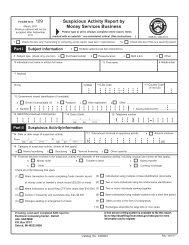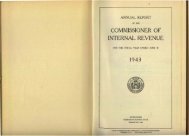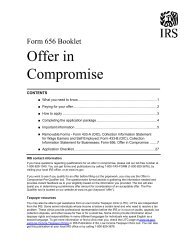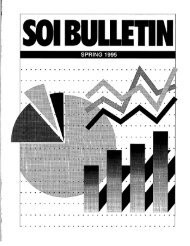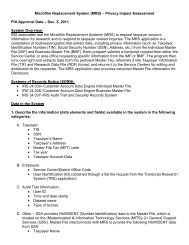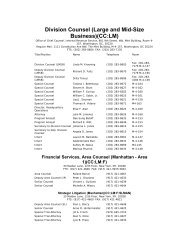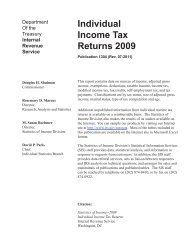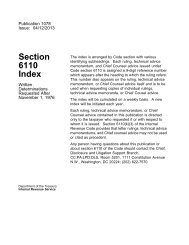200335032 - Internal Revenue Service
200335032 - Internal Revenue Service
200335032 - Internal Revenue Service
Create successful ePaper yourself
Turn your PDF publications into a flip-book with our unique Google optimized e-Paper software.
INTERNAL REVENUE SERVICENATIONAL OFFICE TECHNICAL ADVICE MEMORANDUMNumber: <strong>200335032</strong>Release Date: 8/29/2003Index (UIL) No.: 301.01-07 305.03-00356.01-00CASE MIS No.: TAM-169386-02/CC:CORP:B3Taxpayer's Name:Taxpayer's Address:Taxpayer's Identification No:Years Involved:Date of Conference:April 25, 2003LEGEND:Taxpayer =Company =Individual =Holding =Sub =Year 1 =Year 2 =Year 3 =Year 4 =Year 5 =Year 6 =Month 1 =Month 2 =
TAM-169386-022Month 3 =Month 4 =Month 5 =Date 1 =Date 2 =a =b =c =d =e =f =g =h =i =j =k =l =m =n =o =p =q =ISSUE:
TAM-169386-023Whether the distribution of $ h which takes the form of a § 305(b)(1) dividendand is followed by a recapitalization at a later date should be taxed as a dividend or ascapital gain.CONCLUSION:The distribution of $ h is taxable as a dividend because even if the steptransaction doctrine applies to treat the distribution and recapitalization as occurringsimultaneously,§ 1.301-1(l) of the Income Tax Regulations applies to treat the distribution as aseparate transaction.FACTS:The information submitted indicates that Taxpayer is the common parent of aconsolidated group. During Year 1 and Year 2, Taxpayer acquired a% of the commonstock of Company, a corporation. 1 The remaining b% was owned by an unrelatedindividual (Individual).Between Year 1 and Year 3, the relationship between Taxpayer and Individualdeteriorated and was contentious. Among the disagreements between the parties wasthat Taxpayer wanted Company to make annual dividend distributions of a significantportion of its current earnings, while Individual preferred that Company retain anyexcess cash for expansion and growth. From Year 2 on there were numerousdiscussions regarding a sale of Taxpayer's interest in Company, Taxpayer's purchaseof Individual's interest, or a sale of both interests to a third party. However, the partiescould not come to terms.In early Month 1 of Year 3, Individual proposed two alternatives for purchasingTaxpayer's Company stock. First, Individual proposed to purchase the stock for $ cpursuant to which Taxpayer would receive net after tax proceeds of $ d. Second,Individual proposed that Company distribute to Taxpayer a dividend of $ e andIndividual purchase Taxpayer's stock for $ f. Under the second proposal, Taxpayerwould receive net after-tax proceeds of $ d for its stock and Individual would indemnifyTaxpayer for any tax resulting from the characterization of the dividend as proceedsfrom the sale by Taxpayer of its stock.1 Taxpayer subsequently transferred the stock of Company to Sub, a whollyowned subsidiary of Taxpayer and a member of the consolidated group, in anonrecognition transaction. After that transfer, however, Taxpayer continued torepresent Sub in all matters relating to Sub's ownership of the Company common stock.In this memorandum, for purposes of simplicity, Taxpayer will be treated as the ownerof the Company common stock owned by Sub.
TAM-169386-024Negotiations ensued in which variations on the above proposals were discussed,including converting Taxpayer's common stock into preferred stock after a distribution.Taxpayer and Individual finally agreed that Company would declare a dividend in thetotal amount of $ g that was payable, at the election of the shareholders, either in cashor additional shares of Company common stock. Up until the moment at which eachshareholder made its election, each was free to receive its share of the dividend in cashor stock.On Month 2, Date 1, Year 3, Individual contributed his common stock inCompany to a wholly owned corporation (Holding). Four days later, Company declareda pro rata dividend in the amount of $ g that was payable, at the election of itsshareholders, in either cash or additional common stock of Company. The followingday, Taxpayer elected to receive its share of the dividend in cash which amounted to$ h, and on the next day, Holding elected to receive its share of the dividend inadditional shares of Company common stock. Because Holding received additionalshares of Company common stock and Taxpayer did not, Holding's percentage ofoutstanding stock of Company went up to i% while Taxpayer's decreased to j%.Taxpayer reported the cash received in the amount of $ h as a dividend receivedfrom a 20%-owned corporation taxable under § 301(c)(1). Taxpayer takes the positionthat the cash received in the amount of $ h is a distribution under § 305(b)(1), thustreated as a distribution under § 301. Taxpayer therefore claimed an 80% dividendsreceived deduction (DRD) under § 243(c) (permitting such deductions in the case ofdividends received from a 20% or more owned corporation) in the amount of $ k onTaxpayer's Year 3 consolidated Federal income tax return. 2 It is assumed thatCompany had earnings and profits in excess of $ g.In connection with the purported dividend and other agreements entered into inlate Month 2, Year 3, Taxpayer and Holding amended their shareholders agreement toprovide that either Company shareholder could cause Company to pay a pro-rata cashdividend in an aggregate amount equal to the lesser of (i) $ l per month, (ii) the amountpermitted to be distributed under the credit agreement to which Company was a party,or (iii) the maximum dividend that Company could pay under state law.In Month 3, Month 4, and Month 5 of Year 4, Company paid the $ l monthlydividends, until the shareholders agreement was revised in conjunction with theRecapitalization, described below.During Month 5, Year 4, after certain banks gave Individual their consent,Taxpayer, Holding, and Company agreed to and consummated an exchange byTaxpayer of all of its Company common stock for Company preferred stock (the2 Technical Advice was not requested, and this memorandum does not opine,concerning whether the proper DRD is 80% or 70% or whether § 1059 applies.
TAM-169386-025"Preferred") with an aggregate par value of $ m and a redemption value and liquidationpreference in the same amount (the “Recapitalization”). The Preferred had an n%dividend rate which would increase o% each year after p years, to a maximum of q%. Italso included certain accelerators if any dividend was not paid timely. It also providedthat Company could, but was not required to, redeem the Preferred at par value at anytime after Date 2. Taxpayer could not require Company to redeem the Preferred, norwas the Preferred mandatorily redeemable on a certain date.Taxpayer reported all distributions received from Company with respect to thePreferred as dividends under §§ 316 and 301(c)(1). In four separate transactions inYear 5 and Year 6, the Preferred was redeemed. For purposes of this memorandum, itis assumed that the Preferred is properly treated as preferred stock for Federal taxpurposes.The Examining Agent and Appeals Officer argue that the Year 3 distribution of$ h should not be respected as a dividend. They argue that the distribution and theRecapitalization should be stepped together under the step transaction doctrine and, ineffect, should be treated as occurring simultaneously. Accordingly, the $ h should betreated as "other property" received in the Recapitalization under § 356(a)(1) and gain,rather than dividend income, must be recognized.The Examining Agent raises an additional argument that the $ h paymentreceived by Taxpayer from Company in Year 3 be treated as received in partialredemption of Taxpayer's Company common stock.Taxpayer argues that the distribution and Recapitalization should not be steppedtogether, but even if the distribution and the Recapitalization are treated as occurringsimultaneously under the step transaction doctrine, § 1.301-1(l) requires that thedistribution still be classified as a dividend.LAW AND ANALYSIS:In analyzing the Federal tax consequences of the transactions described herein,we will first assume that the distribution of $ h to Taxpayer and the subsequentRecapitalization are steps of a single transaction at the conclusion of which Taxpayerwould have no common stock in Company. After analyzing the transaction with thisassumption, we will then, if necessary, determine if the step transaction doctrineproperly applies to treat the transactions described herein as steps of a singletransaction.Section 305(b)(1) provides that if a distribution is, at the election of any of theshareholders payable either (A) in its stock, or (B) in property then the distribution shallbe treated as a distribution of property to which § 301 applies.
TAM-169386-026Section 356(a)(1) provides that if §§ 354 or 355 would apply to an exchange, butfor the fact that boot was also received in the exchange, then gain, if any, shall berecognized, but not in an amount in excess of the boot. Section 356(a)(2) provides thatif an exchange described in § 356(a)(1) has the effect of the distribution of a dividend,then the gain recognized therein shall be treated as a dividend, but not in excess of therecipient’s ratable share of the distributor’s earnings and profits.Section 1.301-1(l) provides: "A distribution to shareholders with respect to theirstock is within the terms of section 301 although it takes place at the same time asanother transaction if the distribution is in substance a separate transaction whether ornot connected in a formal sense. This is most likely to occur in the case of arecapitalization, a reincorporation, or a merger of a corporation with a newly organizedcorporation having substantially no property. "Rev. Rul. 69-34, 1969-1 C.B. 105, provides that cash received in arecapitalization in lieu of fractional shares is subject to § 302 if the cash represents amere mechanical rounding off of fractional share interests and is not separatelybargained-for consideration. Otherwise, the distribution will be treated either as thereceipt of boot under § 356(a) or as a distribution to which § 301 applies, dependingupon all facts and circumstances involved, citing § 1.301-1(l).Rev. Rul. 72-57, 1972-1 C.B. 103, applied Rev. Rul. 69-34 to the following factpattern. Corporation X had $ 5 par value common stock outstanding of whichCorporation Y owned approximately 99%. The remaining stock was held by variousminority shareholders none of whom owned as many as 10 shares. In order toeliminate the minority shareholders, X issued one new share of $ 50 par value commonstock in exchange for 10 shares of the existing stock and paid cash in lieu of fractionalshares. Rev. Rul. 72-57 held that the cash received by Y is treated under § 302 ashaving been received in redemption of fractional share interests.Rev. Rul. 78-351, 1978-2 C.B. 148, modified Rev. Rul. 72-57. Rev. Rul. 78-351states that Rev. Rul. 69-34 does not apply to Y in the facts of Rev. Rul. 72-57 becausethe sole business purpose of the reorganization described therein was to eliminate theinterest of the minority shareholders. Accordingly, Rev. Rul. 78-351 holds that the cashreceived by Y must be treated as boot in the recapitalization under § 356(a), taxableunder its facts as a dividend under § 356(a)(2). However, the ruling notes that "[i]f thecircumstances were such that the transaction was essentially a device by Y to withdrawcorporate earnings, the provisions of section 1.301-1(l) of the regulations would apply tothe cash received by Y."In Rev. Rul. 61-156, 1961-2 C.B. 62, a target corporation sold all of its assets toa newly formed acquiring corporation in exchange for acquiring stock, acquiring notesand cash. Acquiring then issued 55% of its stock to the public. Target then liquidated,distributing 45% of Acquiring stock, cash, and notes to its shareholders. The revenueruling held that the transaction was a reorganization within the meaning of
TAM-169386-027§§ 368(a)(1)(E) and 368(a)(1)(F). With regard to the cash and other property receivedby the target shareholders, the revenue ruling focuses on whether the shareholdersexchanged part of their target stock for boot in the reorganization under § 356 orwhether the shareholders received a separate distribution under § 1.301-1(l).The ruling, in effect, finds that the transaction was a mere recapitalization andreincorporation coupled with an unrelated withdrawal of funds and accordingly holdsthat the cash and other property were distributed under § 301 separately from thereorganization. There was no sale because the dominant purpose was to withdrawcorporate earnings at capital gains rates while continuing the equity interest insubstantial part in a business enterprise conducted in corporate form. "The issuance ofstock to new investors was not needed to implement the dominant purpose and,therefore, the rest of the transaction was not fruitless without it and so dependent on it."Applying the relevant authorities to the facts and circumstances (andassumptions) described above, it must be determined whether the distribution of the $ his properly taxable as boot in the Recapitalization or is in substance a separatetransaction. In either case, the economic result to the Taxpayer is the same, i.e., in theend Taxpayer has Preferred and $ h and no common stock. The fact that Taxpayer is acorporation and would be entitled to a DRD if the distribution is treated as a dividend isnot a relevant fact or circumstance.Among the facts and circumstances to consider is the shareholders’ history ofdisagreement concerning the payment of dividends and of attempting to sever theirinterests in Company by way of various types of sales. It was while Taxpayer wasnegotiating to actually sell all its stock that the parties finally agreed to a transactionwhere Company would declare a dividend payable in additional stock or cash. Theparties also discussed Taxpayer's exchange of its common stock for the Preferred, and,for purposes of this memorandum, we are assuming that the distribution and theexchange were definitively agreed upon and that they took place at the same time. Inthe end, Taxpayer had $ h and Preferred and no common stock while Holding still heldits original common stock and the newly issued stock which it received in thedistribution. Although the complete separation of Taxpayer’s and Holding’s interests inCompany may have been the best possible result for Taxpayer, the receipt of an $ hdividend with a continuing interest in Company was a much improved position forTaxpayer than where Taxpayer previously stood.Accordingly, the facts of this case tend to establish that the $ h distributionrepresents separately bargained-for consideration and that the distribution is insubstance a separate transaction from the Recapitalization, notwithstanding that it isassumed that it takes place at the same time as the Recapitalization. Therefore, the$ h distribution is taxable as a dividend.
TAM-169386-028The Examining Agent also argues that the substance of the transaction is thatthe $ h payment received by Taxpayer from Company in Year 3 was received in partialredemption of Taxpayer's Company common stock rather than in the Recapitalization.However, in order for there to be a redemption, Taxpayer must actually surrender stock.See Reitz v. Commissioner, 61 T.C. 443, 448 (1974) aff'd without opinion, 507 F.2d1279 (5 th Cir. 1975) and Estate of Durkin v. Commissioner, 99 T.C. 561, 570 (1992).See also Merrill Lynch v. Commissioner, 120 T.C. 12, 43 at n. 34 (2003). Under theactual facts at issue, there was no surrender of stock by Taxpayer for the $ h, thus the$ h payment cannot be treated as being made in redemption of Taxpayer’s Companycommon stock.On the other hand, if the distribution and Recapitalization are treated asoccurring simultaneously, arguably, all of the common exchanged by Taxpayer for cashand Preferred could be bifurcated to treat a portion of the common as exchanged forthe Preferred in a recapitalization and a portion as redeemed at the same time for $ h.Nevertheless, the analysis set forth above is equally applicable to the bifurcationargument and therefore the $ h is not taxable as redemption proceeds.Based on our analysis above that the $ h distribution is taxable as a dividendeven if the transactions are stepped together, it is unnecessary to determine whetherthe step transaction doctrine applies to the facts at issue.CAVEAT(S)A copy of this technical advice memorandum is to be given to the taxpayer(s).Section 6110(k)(3) of the Code provides that it may not be used or cited as precedent.Ken CohenSenior Technician Reviewer, Branch 3Office of Associate Chief Counsel (Corporate)


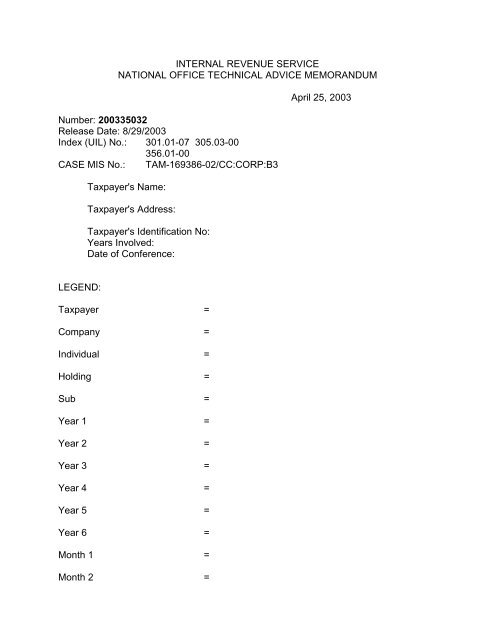
![l..l.l.L. 4DB.DI3-l]t] xxxxxxxxxxxxxxxx - Internal Revenue Service](https://img.yumpu.com/51302394/1/190x245/llll-4dbdi3-lt-xxxxxxxxxxxxxxxx-internal-revenue-service.jpg?quality=85)
